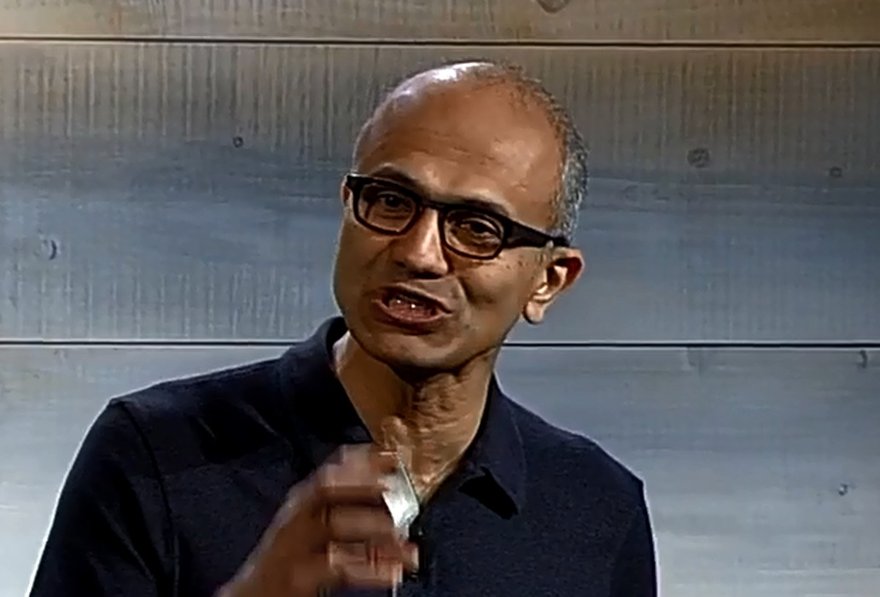Microsoft promised a cloud "inflection point" in its briefing on Monday, but delivered a lackluster set of announcements, including larger "G family" virtual machines for Azure, and a co-branding initiative with Dell for on-premise Azure clouds, cdelivered in a box.
Far more important were deals designed to ease two of the most important IT trends into the Azure public cloud, making it a better place for DevOps and Big Data. By putting the CoreOs Linux version and the Cloudera Hadoop distribution into the Azure marketplace, Microsoft pushed two hot buttons, while Satya Nadella's speech left many cold.
Making Big Data easy
Hadoop has been a runaway success, allowing an easy enty into the once-esoteric world of analytics, but it has not fit well in the public cloud. Spinning up instances of Hadoop has been difficult or, for customers demanding high performance, impossible.
Microsoft aims to change that, with a self-provisioning instance of Cloudera Hadoop in the Azure Marketplace announced by Cloudera co-founder and chief strategy officer Mike Olson. Cloudera produces one of the leading commercial implementations of Hadoop, but Olson thinks it needs to be on the public cloud.
"We’ve got lots of customers with big data infrastructure in their private clouds back at home," said Olson. "We believe data’s going to live where it’s born... If we’re going to realize our vision of unlocking the value of big data, we’ve got to run in the public cloud. We’ve got to be where that data is. By embracing Azure, by making sure that Cloudera runs in a fantastic, easy-to-use way on Azure, we unlock that value. We’re able to combine our back-end tooling with the fantastic Microsoft user interfaces [and] exploratory tools, to deliver way more value on that big data than we ever could before."
In a demo, Olson instantiated Cloudera on Azure, and polled the database using Microsoft’s Power BI front-end on Office 365. Using Microsoft’s radically refined Azure Marketplace portal, Olson was able to spin up a 90-core instance of Cloudera, without even stopping for breath. Power BI makes analytical reports on Cloudera immediately visible and adaptable; and Olson also announced a connection tool making Cloudera data on Azure visible and queriable using locally installed Microsoft Excel spreadsheets as clients.
That connection takes four hops: from the Cloudera Enterprise database to Cloudera's SQL-based query tool Impala, to an ODBC driver produced for Impala that queries data remotely, to Excel which contacts the ODBC driver. As originally conceived, ODBC was the original tool for making structured data visible to applications produced with Microsoft’s languages (such as Visual Basic), and with Office’s current functionality language, VBA. So Excel did not need to be radically reconfigured.
As a result of this, users can produce at least rudimentary dashboard analysis tools with large quantities of Hadoop data in the Azure cloud, most of it without any programming whatsoever.
What will only be determined after some months of initial use is Hadoop’s performance with the present iteration of the Azure public cloud. One reason big data implementations have been done privately, whether on a cloud platform like OpenStack or bare metal, has been because multi-tenancy tends to rock the boat for the processors hosting Hadoop. The reason Hadoop performs as well as it does is due to its use of parallel processing, which multicore processors tend to do rather well... when they have nothing else to do.
Engineers and developers call this perfect state of nirvana determinism, which refers to the predictability of the underlying data engines. Without it, Hadoop can’t predict for itself what resources are available for big data tasks.
Microsoft touts the high performance of its Azure cloud, which is run primarily on variations of Windows Server and its Hyper-V hypervisor. But whether Azure can provide the appropriate level of determinism will only be determined, if you will, after the first public trials.
CoreOs supports containers
The arrival of CoreOS on the Azure cloud added more support for containers - a virtualization scheme where applications run in sandboxes on a kernel - which is seen as an enabler for faster development and delivery of applications.
Microsoft announced that instances of the container-friendly CoreOS version of Linux will be available on Azure, which made a strong follow-up to last week’s potentially epic announcement that the Docker containerization platform will come to Windows.
"We think container-based approaches like Docker will be great, both to increase server density and enable existing applications to run even more cost-effectively on fewer amounts of infrastructure," said Microsoft cloud vice president Scott Guthrie. "But we also think that the container-based approach helps dramatically with the development of next-generation applications, and enabling them to be deployed even more efficiently as well."
t’s what we’ve done over and over again in terms of the platforms that we have delivered into the marketplace."
CoreOs is a version of Linux, forked from Chrome, which uses Docker to manage Linux containers. The CoreOS team described themselves as "excited" and pointed out that the deal makes CoreOS easier to use as CoreOS instances will get patches automatically, which means "never having to spend time manually rolling out OS updates again"
Monday’s announcement may have been a milestone for big data in public clouds, and possibly for containers.
What it was not, was a major advancement in the "Cloud OS." Not long ago, Microsoft touted Windows Server as the "Cloud OS." But the company is clearly no longer interested in competing against Linux for the foundations of the data center. In recent days, references to Windows Server have actually been removed from Microsoft’s online sales brochures for "Cloud OS" and/or "The Microsoft Cloud."
The Big Data and container news saved the day for Microsoft. But in Microsoft's long history, it was far from the first instance of an audience suffering from a long-winded speech, being saved by a demo.
Peter Judge contributed to this article.

